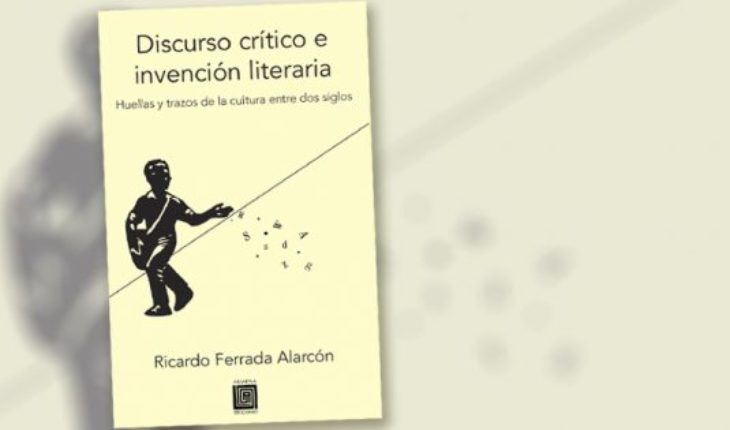critical discourse and literary invention. Tracks and traces of culture between two centuries (2018) of Ricardo Ferrada, is an exegesis that gives researchers and students elements to understand, in depth and breadth, a series of perspectives and results in critical exercise referred to the speech literary, aesthetic and political reach of the poetic and the significance of emblematic novels in the configuration of cultural identities.
The work is articulated in three chapters, whose internal drive motivates the reader’s interest and allows you to move forward, with fluency and clarity, where the author discerns from his experience in themes, shapes and references in literature and Latin American thought, of educator and scholar of the complexity of the literary language. Thus, in each section of the book, it delivered new evidence for appraising the significance and capacity Dialogic literature, in a Europe in the process of emancipation; this writing style leads to the encounter between the rigor of the researcher and those interested by new options of literary interpretation.
Each of the texts that make up the volume, although they respond to compositions in different academic Ricardo ferrada intellectual occupation times, maintain a sequence ranging from magazines to international meetings, thesis and conversations with colleagues and young beginners. As well noted by the author in the introduction, “the sense of this book is based on the idea of promoting a corpus of critical studies, whose orientation is the delivery of different approaches to the production of Chilean and Latin American writers”.
Each milestone is justified by the interest in showing that literature is not a mere hobby, but a speech originated in “founding concepts”, is consolidating through different genres and aesthetic approaches, which demand an effort by decant theories and designing new methodological resources. No doubt that this work unit, is assembled in its object and in the for what, whereas critical in the tradition of the speech and its cultural impact studies.
The first part relates to criticism and literary processes. The Latin American essay as form and expression of the narrative of ideas. Deals with the phenomenon of modernism, and insinuated a discussion that moves towards the native Word authentication, with a new “temple of spirit” aesthetic and political contribution to the development of a continent in its entry into modernity. Also deals with the literary avant-garde and its links with blackness, new collective imaginary and critical thinking. Octavio Paz will tell us that “criticism is creation, to the extent that art has been and is critical”. The second part contains five articles, whose vectors relieve the importance of Aime Césaire and the Negritude in the construction of the African identity in America. Appears in the substrate of the reflections, jazz, as learned and symphonic music; the tradition of the spiritual in the United States and the presence of Breton in the fights for liberation in Haiti. The recognition of the protodiscursos on colonialism, moves to the moments of the Mexican art and the historical incidence of poetry. Geographical circle is completing with the presence of Pablo de Rokha and Pablo Neruda, poets of militancy and a pragmatism that seeks the dialectical synthesis between reality and poetry. Noteworthy is the definition of Pablo de Rokha gives art, saying “that is social language of the times and peoples” (remembering to Raimundo Contreras). For both, the poetry will take care of the processes of insurrection. It is concluded with reflections dedicated to “Enrique Lihn or the aesthetics of provocation” and “the marvelous and the fictionalization of the subject” in the work of Tomás Harris. Lihn, poetry is “a protest against the reality that presupposes estrangement and alienation”; and for Harris, from his book wonderful Chronicles (1996), the epic “subverts the codes of writing up to the loss of the likelihood”. The third part refers to the novel Latin American and Chilean, from lost (1953) steps of Alejo Carpentier, passing through the interpretation of an empty House (1996) Carlos Cerda and fenced (1970) of Lina Meruane, closed the circle with the Mapocho novel) 2002) by Nona Fernández. Reading this chapter invites us to travel through the mythical time of a surreal and wonderful territory, to feel a sort of cultural symbiosis in the dialectics of identity, rejection of social hell created by Pinochet’s dictatorship and to perform other readings of the past, in the middle of unresolved conflicts that still lacerating the collective memory. South America would be a vacuum without the presence, urgent, timely and transgressive space of its literature, music and the call to release processes.
The book I present is the verification of the assumptions of the cultural fabric of the big stories that make up the identity in the diversity of a continent. Valuable contribution, epistemological and pedagogical, for insiders and researchers from the aesthetic and cultural phenomena.
Ricardo Ferrada, critical discourse and literary invention. Tracks and traces of culture between two centuries, Ariadna Ediciones, Santiago, August 2018 José Alberto de la Fuente. Academic Catholic University Silva Henríquez content poured into this op-ed is the sole responsibility of the author and do not necessarily reflect the editorial line nor the counter position.
translated from Spanish: Book “critical discourse and literary invention. Tracks and traces of culture between two centuries”
September 1, 2018 |





